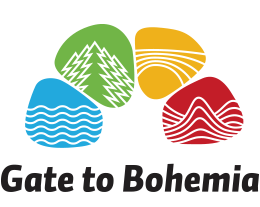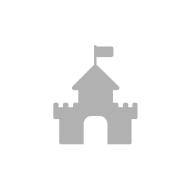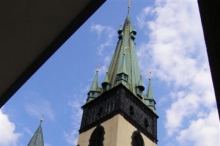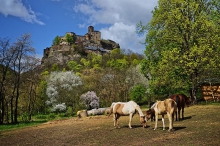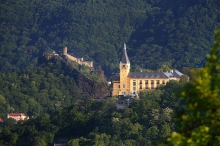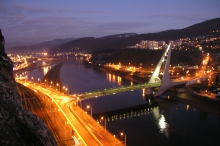Ústí nad Labem is situated in the heart of the protected landscape area of Central Bohemian Uplands. It is an area which is dominated by the Elbe Valley and Porta Bohemica, so called “Gate of Bohemia”. The landscape is typical of an area formed by the cones of extinct volcanoes. A number of sightseeing spots and lookout towers, such as Větruše and Erben Lookout Tower, offer amazing and magnificent views of the countryside.
Ústí is surrounded by mountains with the peaks of the Ore Mountains rising steeply not far to the north of the city as well as the rocky labyrinths of the Elbe Sandstone Mountains and Bohemian Switzerland National Park located nearby. The life of the city has always been closely connected to the water. The Elbe River is a major European waterway and is used both for freight and recreational cruises. Another important river for Ústí is the Bílina River that flows into the Elbe near the city centre. Numerous streams that converge towards the Elbe have created beautiful cascades and waterfalls around Ústí nad Labem. One of the most famous and most visited waterfalls is Vaňov Waterfall and altogether we can find twelve of them located near to the city. In Chabařovice, a nearby village, Lake Milada was created by flooding the brown coal mine.
Church of the Assumption of the Virgin Mary
The Roman Catholic Church of the Assumption of the Virgin Mary is located in the city centre. The first written record of the church comes from 1249, but it had already existed as early as at the end of the 12th century. The main gothic wing altar dates back to 1498. The present nave was built at the turn of the 15th and 16th centuries. Significant changes occurred after construction at the end of the 19th century according to the plans of architect Josef Mocker. The dominant Neo-Gothic portal of the western facade is the work of architect Antonio Weber. In April 1945 the church was damaged by the bombardment of the city and its tower deviated from the vertical axis by approximately 2 meters. Religious services and classical music concerts are conducted in the church.
Church of St. Adalbert
The first written report directly relating to the Church of Saint Adalbert dates back to 1342. The present church was built between 1704 and 1734. The building was managed by a Baroque architect Octavian Broggio based in Litoměřice. The most interesting part of the building is the main entrance facade with its two prismatic towers. Two niches with the statues of St. Wenceslas and St. Ludmila are located on the first floor of the facade and on the ground floor of the facade there are the statues of St. Dominic (on the left) and St. Thomas Aquinas (on the right). The main portal ends with the statue of St. Adalbert. A massive church organ that is still in use today dates from 1972. It has 3572 pipes, the largest of which exceeds 6 meters. Currently, various exhibitions and concerts are being held in the church.
Church of St. Paul the Apostle
The Evangelical Church of St. Paul the Apostle is located in the city centre, in Winston Churchill Street. Both the origin and history of the church are very intriguing. During the 19th century Protestants from neighbouring Germany started to come to a fully Catholic city as entrepreneurs and skilled labour. After they gained full religious equality with the Catholics in 1861, they set up a chapel at the corner of today's Panská and Brněnská streets. However, the chapel was too small and not representative enough, so after obtaining some funds (partly from the German Gustav Adolf Foundation), a genuine evangelical church was built in 1904-06. The church formed the major viewpoint of the then most luxurious street in Ústí nad Labem (now Winston Churchill Street). The churches interior dates from its time of construction and it bears many Art Nouveau features in contrast to the clearly neo-Romanesque exterior. The church was slightly damaged during the bombardment of the city centre at the end of the WW 2. After that, the church was poorly maintained, but this has gradually improved in recent years.
North Bohemian Theatre of Opera and Ballet
The North Bohemian Theatre was built between 1908 and 1909 and was based on the design of architect Alexander Graf. It was opened on 21st September 1909 by showing a play called “Sappho” in which the leading actor was Maria Pospischilová, who also became the first director of the theatre.
Drama studio
The drama studio in Střekov was established in 1972 and many famous Czech actors such as Jiří Bartoška, Karel Heřmánek and Jan Hrušínský started performing here. After the devastating flood of 2002, the building underwent extensive reconstruction.
City Gardens
The recently improved city park offers leisure time activities for all ages (playground with equipment for exercising, petanque, suitable terrain for roller skating and skateboarding). The park also includes a concert pavilion, the so called "Mušle", which is suitable for performing theatre productions and concerts.
Větruše Chateau
Větruše Chateau is one of the dominant landmarks of Ústí nad Labem, since it offers an unforgettable view of the city. Based on legend, its history dates back to 826, when a nobleman called Labohoř built a castle here in order to protect himself against his enemies and named it “Vitruš” in honour of his wife. In 2002, Větruše was completely dilapidated and was bought by the municipal authority of Ústí nad Labem, which started its extensive reconstruction. Today it houses a hotel and a restaurant, an observation tower, a natural and mirror maze, and sports grounds is located within close proximity. Since the autumn of 2010, Větruše and the Forum shopping centre has been connected via a cable car with its base in the Forum.
Větruše is the starting point of two nature trails. By taking the nature trail from Větruše to Vrkoč you can reach Vaňov waterfall on the Podlešínský Brook. The nature trail from the medieval place of execution located at Větruše will take you to Ústí underground which is a common name for the Museum of Civil Defence and the children's amusement park.
Palace mansion of C. F. Wolfrum
The Wolfrum family belonged to the most important entrepreneurial families in Ústí nad Labem. In 1843, Carl Georg Wolfrum founded a dyeing plant in the yards between the streets of Velká Hradební Street and Dlouhá. Later, the weaving mill was added to the plant. In 1851, the first steam boiler started to operate there. In 1887, Carl Wolfrum´s sons, Carl Friedrich and Otto, transferred most of their production to a new site in the western industrial area of the city in Předlice (later Vlnola, textile production stayed here to the early 1990s). Carl Friedrich Wolfrum built a large neo-Renaissance palace-type mansion in the English park in 1897-99 according to the Hans Miksche´s project, a Viennese architect. Thanks to its location on the upper part of the steep slope above the city centre, the mansion dominated the landscape until the construction of the prefab estate “Skřivánek”. The mansion remained the property of the Wolfrum family until 1945, and then became the property of Czech Radio. It has been listed as a cultural monument since 2005.
Masaryk Sluice
Masaryk Sluice is listed as a significant technical monument. The sluice with its power plant and navigation lock was built between 1923 and 1933. The structure consists of three parts. The first is the weir itself, which raises the level of water above the sluice, the second part consists of two navigation locks, and the third part - the hydroelectric power station - is used to generate electric current. At the time of its completion the sluice was the largest waterworks in the country. It connects two parts of the city, Střekov with Vaňov via a pedestrian crossing and a cycle path built above the weir. Guided tours of the sluice are available upon booking in advance.
Střekov Castle
The romantic ruin of Střekov Castle from the 14th century is one of the finest preserved castle ruins in the Czech Republic. Its silhouette on a steep rocky ridge over the Elbe River has been the symbol of the city for centuries. The castle was built by a Prague burgher, Pešek of Veitmile, but it was John of Luxembourg, the King of Bohemia at that time, who initiated its construction in order to secure navigation on the Elbe River. The castle has belonged to the House of Lobkowicz since 1563. Nowadays the castle is a sought-after tourist attraction and is a location where various exhibitions, cultural events and night tours take place.
Mariánská Rock
The Mariánská Rock proudly overlooks Ústí embankment A Baroque chapel dating from 1688 built in memory of averting the plague used to stand on the site, but the chapel was demolished in the 1970s. Mariánská Rock commands a beautiful view of the Elbe valley. From a geological point of view, Mariánská Rock and Střekov opposite, are the only formation that was divided by the Elbe River.
Mariánský Bridge
In Ústí nad Labem are three bridges that cross the Elbe River. The first one, the railway bridge, is the eleventh largest building of its kind in our country. The second, Dr. Edvard Beneš Bridge, is a road bridge and was built in 1936. It is still one of the largest bridge constructions of this type. The third and the newest bridge is the Mariánský Bridge which was listed amongst top ten most beautiful buildings built in the last decade of the 20th century according to an international poll conducted by a renowned magazine “Structural Engineering International” in 2001.

